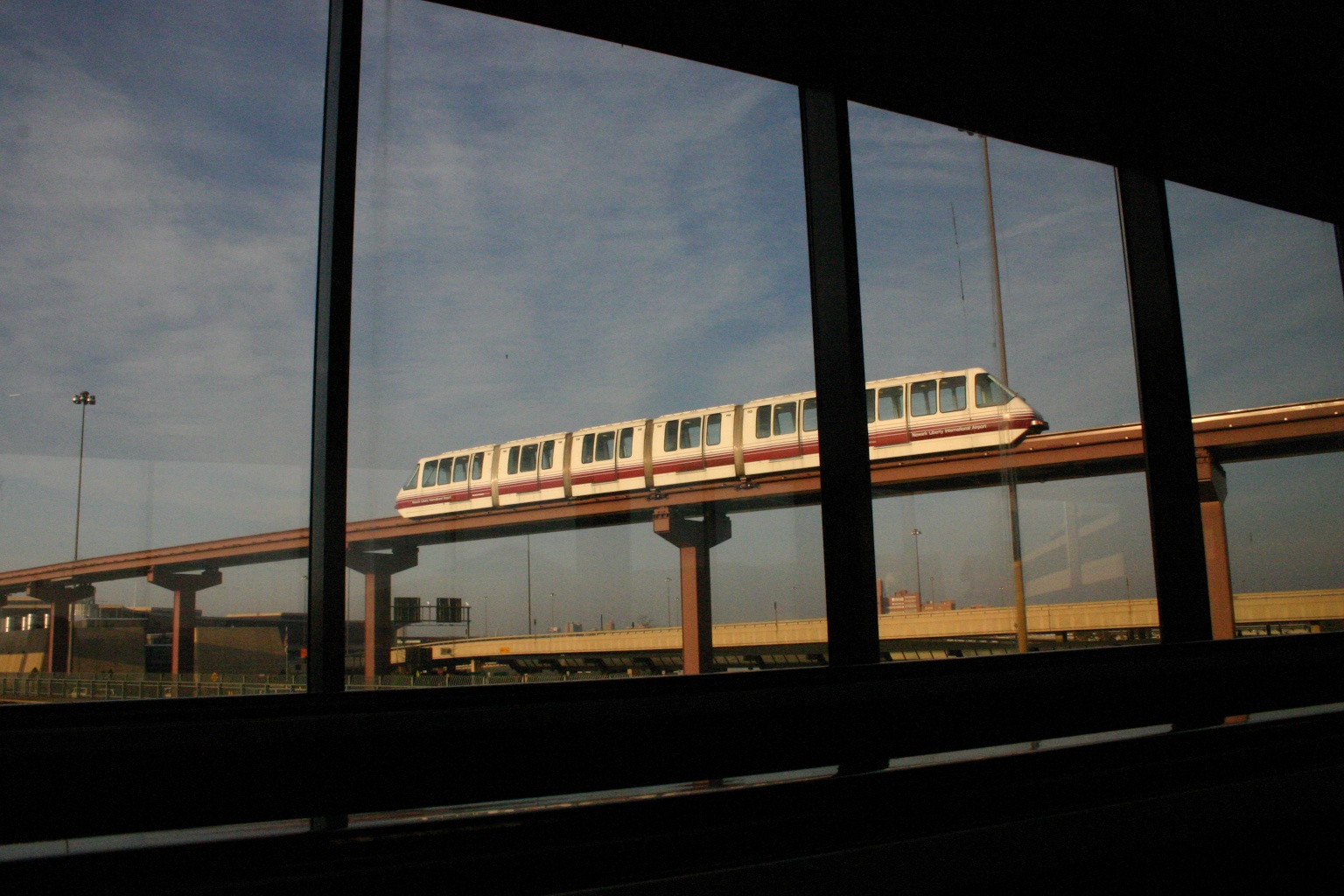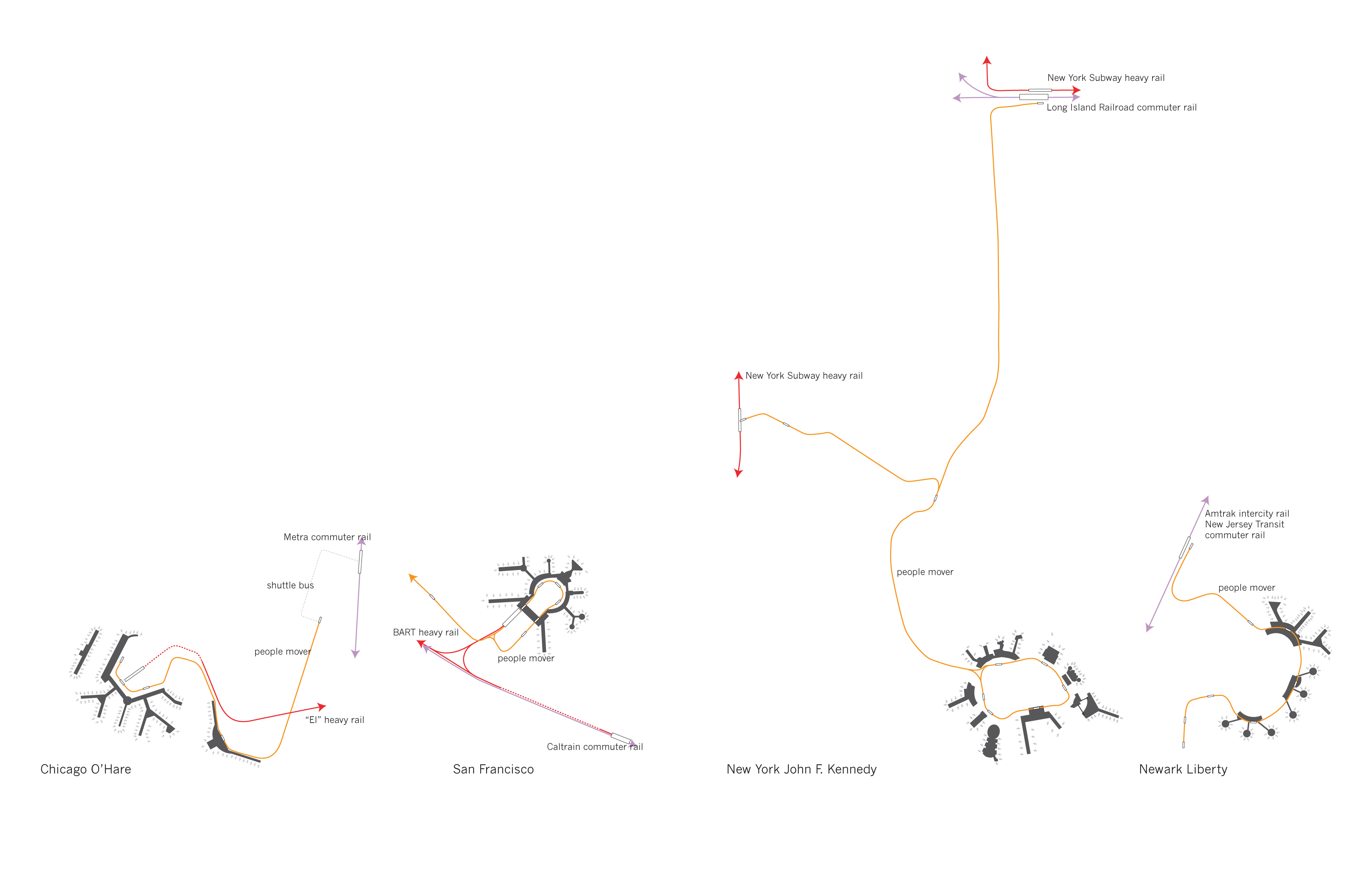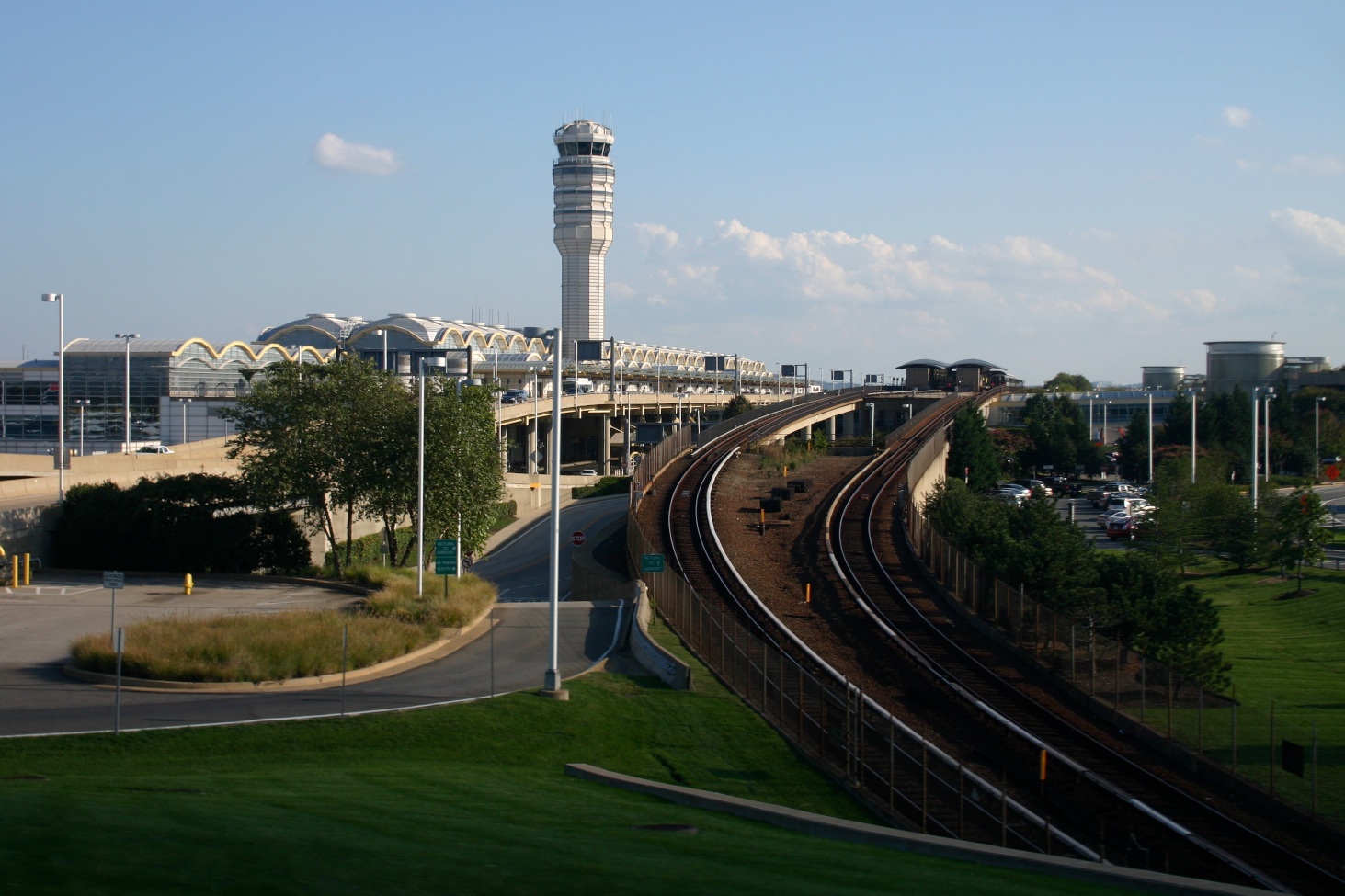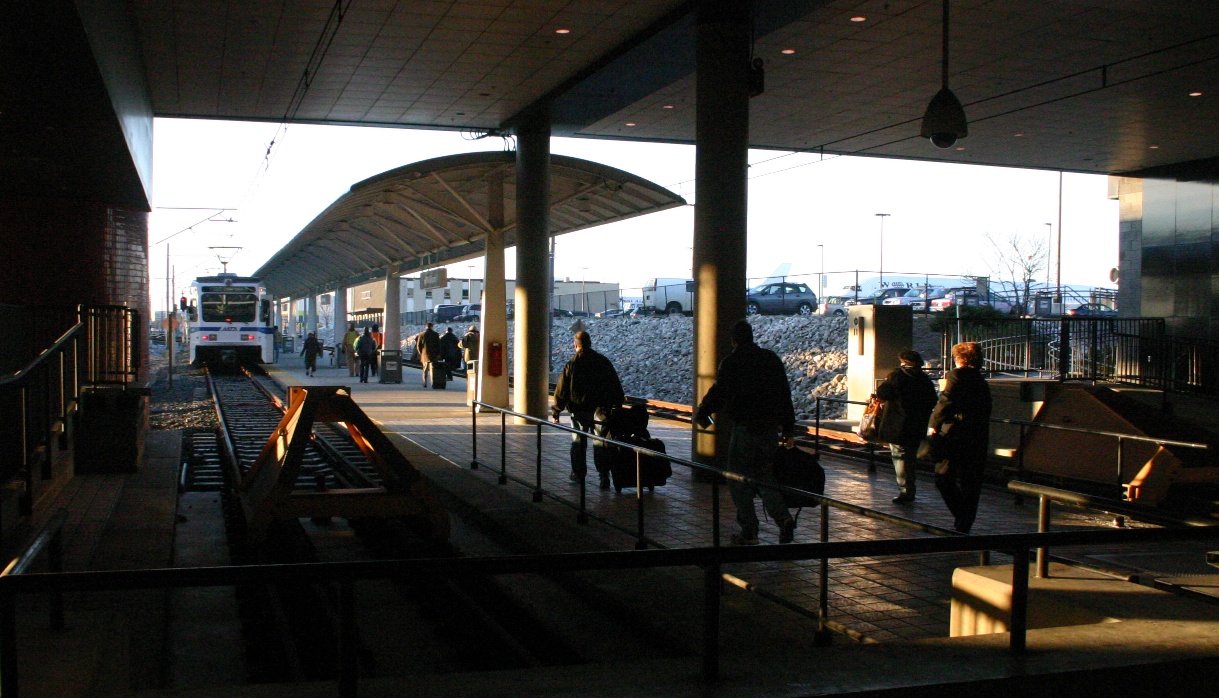The Train to the Plane
[ezcol_1half id=”” class=”” style=””]
When a city plans a rail new transit system, it is almost inevitable that a connection to the airport is included. That’s a reflection of the importance of plane travel, which has become ever cheaper and more widely used. But it’s also a product of transit politics. Many rail planners have discovered that the numbers don’t seem to justify such a connection; employment centers generate many more riders, and bringing a rail line into an airport is often complicated and expensive. But the public sold on airport connections; someone who takes the train to the airport every few months has as many votes as someone who rides to work every day.
The first rail connection to a U.S. airport was Cleveland in 1968. That station was directly inside the airport, setting a pattern for systems to follow. This remains the “holy grail” of airport rail connections. Probably the best example of the type is at Atlanta’s Hartsfield Airport, where the station was built as part of the terminal, an escalator ride away from baggage claim and closer to the ticket counters than the parking garage. Elsewhere, stations were included in the basements of parking garages (Chicago O’Hare), slipped in alongside drop-off lanes (Philadelphia) or tunneled below the airport (Minneapolis).
Unlike Atlanta, many airports have multiple terminals. This design tailors to cars, distributing traffic and putting the drop-off lanes closer to the gates. But it’s hard for accommodating transit. Philadelphia solved the problem by putting a station at each terminal; a train to the airport stops at each one in turn. That’s even harder to engineer, though, than a station inside one terminal, especially at airports that have grown haphazardly. A more common solution is to use an automated people mover to link to terminals to a single transit station. Many airports are adding such people movers to connect terminals to each other (important in an era of airline alliances, where many passengers transfer from one terminal to another) and to parking lots and rental car centers. Once such a system exists, it’s not hard to extend it to a rail transfer station. People movers, with small vehicles suited to steep grades and tight curves, are easier to fit into an existing airport. Even more importantly, they make it easy to link existing rail lines to the airport, as has been done at New York’s airports.
Nothing is less expensive, though, than operating a shuttle bus to the airport from a nearby rail station. This is by far the most common air-rail connection. The shuttles usually run frequently, directly from the station to the terminals, and they are indicated on rail maps and timetables. In some cases, a shuttle bus is a temporary measure until a rail extension or people mover is built, but other airports – like Boston – have used such connections for years.
Even the most convenient rail connections, though, serve only a portion of airport passengers. Even at National Airport, with a convenient connection to one of the most comprehensive rail systems in the country, only 15% of passengers ride rail. In Atlanta and Chicago, that figure is under 10%. There are many reasons for this: passengers with a lot of baggage will not be willing to walk to stations or negotiate elevators and crowded train cars, downtown-centered rail systems will cause trips from other suburban locations to the airport to be much slower than cars, and travelers arriving in an unknown city are more likely to be comfortable with hailing a cab than using a rail system they do not know, regardless of how comfortable it is. But airports are employment centers as well, and airport employees may be more likely to use transit than passengers are.
International travelers know that U.S. airport connections are somewhat lacking by international standards. In London and Hong Kong, non-stop trains connect downtown terminals with airline check-in counters directly to the airport; in Paris and Frankfurt airport rail stations serve not only local transit but high-speed and conventional long-distance trains to all parts of Europe. But such connections are coming to the U.S., too. The Newark airport rail station is the first direct rail-airport connection on Amtrak’s busiest rail route. Continental Airlines had now added Amtrak to its list of airline partners; air passengers can now book a “flight” segment from Newark to Stamford, Connecticut which never leaves the ground.
[/ezcol_1half] [ezcol_1half_end id=”” class=”” style=””]
The train to the terminal
Washington Reagan National Airport’ convenient rail connection (top) resulted not from building a station next to the terminal but from building the new terminal, opened in 1997, next to the station, built in 1977 under the airport’s master plan. Trains run every 3 minutes, and it’s only a 12-minute ride to Downtown. Baltimore-Washington International (bottom) is served by an at-grade light to a stub-end station at one end of the terminal. A separate shuttle bus connection leads to an Amtrak and commuter rail station.
The train to the people mover
People movers are not as convenient as a station in the terminals. But sometimes that convenience is illusory. San Francisco went to great expense to fulfill politician’s promises to put BART inside the airport. The line branches in two; one route extends to a the airport while another connects to a commuter rail (Caltrain) transfer station just outside the airport. But the station is inside the international terminal only; the domestic terminals are a long walk — or a short people mover ride — away. Thus, most passengers transfer to the people mover anyway. Meanwhile, Caltrain passengers headed to domestic flights must transfer to BART, then transfer again to the people mover. Bringing all BART trains and the people mover into the commuter rail station would have been no less convenient for most BART passengers, more convenient for commuter rail passengers, and a good deal less expensive. In fact, that’s exactly what Miami will be doing.
[/ezcol_1half_end]
These diagrams are all to the same scale.
[ezcol_2third id=”” class=”” style=””]People movers reach out
In New York City, where Continental Airlines has a hub in Newark while Delta runs shuttle flights from LaGuardia and Jet Blue is based at JFK, airlines compete on ease of access to each airport. When Airtrain Newark (upper left) opened in 2001, Continental began advertising the new, convenient connection to Manhattan in ads, on its website, and in its inflight magazine (lower left). Airtrain Newark is a single monorail line that connects every terminal to a remote parking lot and to a station serving Amtrak intercity trains and New Jersey Transit commuter rail. It’s the most convenient Amtrak to airplane connection in the Northeast.
The Airtrain JFK connection, built at the same time as Newark’s, is the most extensive airport to transit people mover ever built. One branch runs three miles from the terminals to the Howard Beach subway station; the other nearly five miles along the Van Wyck Expressway to the connected subway and commuter rail stations at Jamaica.
In New York, where the airports are run by a bi-state authority, rail access was a political issue; New York’s approval for Airtrain Newark was contingent on building a similar system at JFK and vice-versa. La Guardia, the smallest of the three metro airports, remains without a rail connection, although before 2001 Delta Airlines offered fast ferry trips to Manhattan.
The train instead of the plane
Amtrak’s Acela Express, which stops at the Baltimore-Washington airport rail station, isn’t just a way to get to the plane: it’s a replacement for the plane. Amtrak carries more people between New York and Washington than all the airlines combined, and that market share is increasing as air travel gets more complicated. In Europe, high speed rail lines in France, Germany, Spain, and Britain have replaced short-haul flights, freeing up airport capacity for long-haul flights.[/ezcol_2third] [ezcol_1third_end id=”” class=”” style=””] [/ezcol_1third_end]
[/ezcol_1third_end]
Airport rail connections in the United States
(Includes direct rail connections, connections via people movers, and connections via dedicated shuttle bus from station near airport. Does not include regular local bus service or longer-distance airport bus service that may happen to connect to rail.)
| airport | mode | system | connection | operating | comments |
| Boston | heavy rail | MBTA | shuttle bus | 1952- | rebuilt 2004 |
| Cleveland | heavy rail | RTA | station in terminal | 1968- | |
| Oakland | heavy rail | BART | shuttle bus | 1972-2014 | |
| Washington National | heavy rail | MetroRail | station in terminal | 1977 – | connected to new terminal in 1997 |
| New York JFK | heavy rail | New York Subway | shuttle bus | 1978-2003 | shuttle bus connection to dedicated express train service from Manhattan 1978-1990; shuttle bus connection to regular trains 1990-2003 |
| Baltimore | commuter rail, intercity rail | MARC | shuttle bus | 1980- | |
| Chicago O’Hare | heavy rail | CTA | station in parking garage near terminals | 1984- | terminal 5 connected with people mover in 1993 |
| San Francisco | commuter rail | Caltrain | shuttle bus | ???-2003 | in service by 1997 |
| Philadelphia | commuter rail | SEPTA | station each terminal | 1985- | |
| Atlanta | heavy rail | MARTA | station in terminal | 1988- | |
| Palm Beach | commuter rail | Tri-Rail | shuttle bus | 1989-1997 | |
| Fort Lauderdale | commuter rail | Tri-Rail | shuttle bus | 1989- | |
| Miami | commuter rail | Tri-Rail | shuttle bus | 1989-1998 | |
| San Jose | light rail | VTA | shuttle bus | 1991- | |
| San Jose | commuter rail | Caltrain | shuttle bus | ???? | |
| Burbank | commuter rail / intercity rail | Metrolink / Amtrak | station connected with open walkway | 1992- | |
| South Bend | commuter rail | SouthShore | station in parking lot | 1992- | primary purpose is not airport connection but use of airport parking lot as park-and-ride |
| Chicago Midway | heavy rail | CTA | station connected with covered walkway | 1993- | |
| St Louis | light rail | MetroLink | station at ea. terminal | 1994- | station at East Terminal opened 1998 |
| Los Angeles | light rail | MTA | shuttle bus | 1995- | |
| Chicago O’Hare | commuter rail | Metra | shuttle bus | 1996- | shuttle bus to people mover |
| Baltimore | light rail | MTA | station in terminal | 1997- | |
| Miami | commuter rail | Tri-Rail | shuttle bus | 1998-2012 | |
| Dallas-Fort Worth | commuter rail | Trinity Railway Express | shuttle bus | 2000- | |
| New York JFK | heavy rail / commuter rail | New York Subway / Long Island Railroad | 2 stations with people mover connection | 2003- | replaced shuttle bus |
| Newark | commuter rail / intercity rail | New Jersey Transit / Amtrak | station with people mover connection | 2001- | |
| Portland | light rail | MAX | station in terminal | 2001- | |
| Anchorage | intercity rail | Alaska Railroad | station connected to terminal with pedestrian tunnel | 2003- | used for chartered cruise ship train only |
| San Francisco | heavy rail | BART | station in one terminal; people mover to others | 2003- | |
| San Francisco | commuter rail | Caltrain | BART shuttle to ariport | 2003-2008 | airport connection now requires double transfer |
| Minneapolis – St. Paul | light rail | station at each terminal | 2004- | ||
| Milwaukee | intercity rail | Amtrak | shuttle bus | 2005- | |
| Oakland | intercity rail | Amtrak | shuttle | 2005-2014 | uses same shuttle bus as BART connection |
| Phoenix | light rail | Valley Metro | shuttle bus | 2008-2013 | |
| Seattle | light rail | Link | station connected with covered walkway | 2009- | |
| Providence | commuter rail / intercity rail | MBTA/Amtrak | station connected with covered walkway | 2010- | Amtrak trains will pass through station without stopping |
| Dallas Love Field | light rail | DART | shuttle bus | 2010- | station in terminal was studied but rejected due to cost |
| Miami | commuter rail, heavy rail | Tri-Rail, Metrorail | people mover | 2012- | replaced shuttle bus |
| Phoenix | light rail | Valley Metro | people mover | 2013- | |
| Dallas-Fort Worth | light rail | DART | people mover | 2014- | |
| Oakland | heavy rail / intercity rail | BART, Amtrak | people mover | 2014- | will replace shuttle bus |
| Denver | commuter rail | RTD | station in terminal | 2016- |




Comments are Disabled